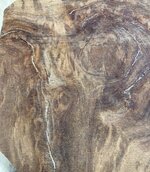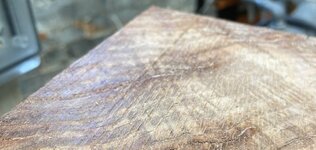MRDucks2
Member
At least from what I understand it is similar to Anchor Seal. As I have begun to break down some larger pieces of wood, just sealing with paraffin wasn't doing the trick. Thick, takes a lot and separates too quickly as really green wood shrinks. Tried the latex paint route but for me it seems to be thin, needing more coats. Plus I am not fond of the Pink I found in an old can in the basement. 
Read about Anchorseal but not available locally and didn't want to wait. Sounds like a good product. If I had Anchorseal readily available I would buy it, but shipping it can nearly double the price of a gallon and increases 5 gallons by about 1/3.
Chased down a few threads on other forums for various recipes and found one that I like and works for me.
Other solvents can be used, but I chose a mineral spirit base so be warned that it is flammable, kills people in California and all of that.
1 gallon mineral spirits
1/3 cup BLO (boiled linseed oil)
8 oz (2 bars) melted paraffin (Gulf Wax)
I mixed the first bar of melted paraffin into the mineral spirits using a small bucket, working outside.
I then added the BLO to the mixture
At this point I tried it out and it didn't seem to leaving much paraffin behind, requiring a second coat.
So, I melted a second bar of paraffin and added that to the mixture. In a single coat, brushed on with a chip brush, I get a nice, thin sealing coat of paraffin. It goes a long way.
I put the entire concoction back into the mineral spirits container and relabeled with contents and recipe.
The idea is that the mineral spirits dissolves the paraffin and it stays dissolved. According to legend the BLO may help it all stay in suspension. Once applied the mineral spirits evaporate leaving a thin wax coating. Oh, and it is non-penetrating so it does not hurt the blanks but does show the finished color/character nicely before turning.
Cost should be a little under $20/gallon in the Midwest.
It may be possible to keep more paraffin in suspension by not sure it is needed. You can just let the mineral spirits dissolve the wax but that takes much longer and I have the patience of a wood turner.
Your mileage may vary. I will report back on how it does over time if there are issues.
If you give it a try please wear eye protection while mixing and using.


Read about Anchorseal but not available locally and didn't want to wait. Sounds like a good product. If I had Anchorseal readily available I would buy it, but shipping it can nearly double the price of a gallon and increases 5 gallons by about 1/3.
Chased down a few threads on other forums for various recipes and found one that I like and works for me.
Other solvents can be used, but I chose a mineral spirit base so be warned that it is flammable, kills people in California and all of that.
1 gallon mineral spirits
1/3 cup BLO (boiled linseed oil)
8 oz (2 bars) melted paraffin (Gulf Wax)
I mixed the first bar of melted paraffin into the mineral spirits using a small bucket, working outside.
I then added the BLO to the mixture
At this point I tried it out and it didn't seem to leaving much paraffin behind, requiring a second coat.
So, I melted a second bar of paraffin and added that to the mixture. In a single coat, brushed on with a chip brush, I get a nice, thin sealing coat of paraffin. It goes a long way.
I put the entire concoction back into the mineral spirits container and relabeled with contents and recipe.
The idea is that the mineral spirits dissolves the paraffin and it stays dissolved. According to legend the BLO may help it all stay in suspension. Once applied the mineral spirits evaporate leaving a thin wax coating. Oh, and it is non-penetrating so it does not hurt the blanks but does show the finished color/character nicely before turning.
Cost should be a little under $20/gallon in the Midwest.
It may be possible to keep more paraffin in suspension by not sure it is needed. You can just let the mineral spirits dissolve the wax but that takes much longer and I have the patience of a wood turner.
Your mileage may vary. I will report back on how it does over time if there are issues.
If you give it a try please wear eye protection while mixing and using.


